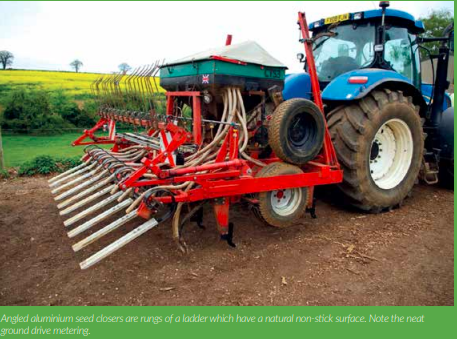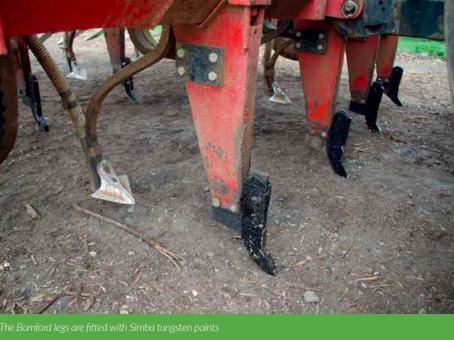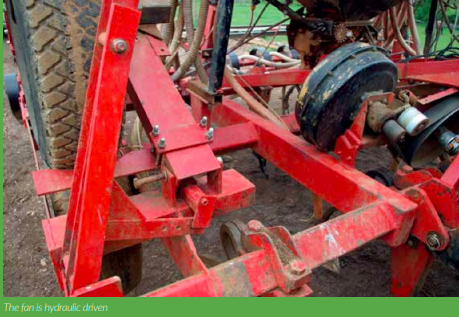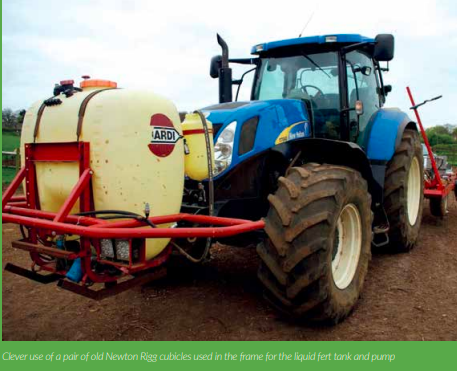There are many and varied reasons why UK farmers avoid making the change to No-till. They know it won’t work on their land. They tried in the 1970s, drilling into the ash left after stubble and straw was burnt off, and yields soon declined. If these aren’t enough the next argument against making change is the cost of machinery which is the deterrent. Spending £80k and more on a new machine which replaces a seed drill that’s good for many more years seems inevitable. Editor Mike Donovan explains
You may have heard of a farmer making his own, and this article shows the detail of how one farmer completed the project. It provides farmers in a similar position with useful ideas. With a great many farms falling into the 600 – 1200 acres bracket, here is a means of getting into direct drilling at a low cost – in fact this one was less that £10,000 and that includes the value of the components, some which were found on the farm anyway. It is especially valuable as it provides an economic answer for the small and medium sized arable farmer. This group remains the largest sector of farmers and the project provides a viable answer to those who might otherwise feel priced out of the market.

The Carswells Northamptonshire farm is 400 acres of arable and 250 of grass. Their cattle enterprise includes a bull beef enterprise and this provides valuable muck for the arable land. Like many farms in Northants their soil varies from blowing sand to heavy clay, and to emphasise just how variable the land is there’s a brickworks on one side of the road outside their village, while on the other they are extracting sand! The variation makes it difficult to choose and buy machinery. About ten years ago they figured that one way to solve the problem was to go to zero-till and put the whole business of cultivation behind.
The change would have greater viability if the cost of the seed drill was low. Rather than buying a cheap, worn out machine and spending thousands on a refurb, the decision was a build that incorporated components already in the yard. The project took some time. As with most of such ideas the project developed, with features added when they were seen as necessary.

The result has been satisfactory yields which in recent years have been on the increase, and of course the costs of crop establishment have been reduced considerably. The drill was built in 2010 with the idea of using it to sow rape and beans but now is used for everything. Drill is built on a 3 metre Bomford Superflow frame Three metres seems small to many farmers who see 6 and 4 metre machines at all the shows and demos. They don’t bother to demo the three metre version. Yet the acreage capacity of the smaller drill is considerably. Examples of 3,000 acres being planted with 4 metre machine sound impossible. Yet divide the land into autumn and spring sowing, spread the work over from August osr to beans in November and similarly in the spring. Then, most importantly, factor in the elimination of seedbed preparation. That 4m sounds like it might do the job okay. Not only this, it needs a smaller, lighter tractor.
The seeder is Accord, the frame is a Bomford cultivator, and the leg spacing is 34 cm or 13ins. The legs are the originals from the Superflow and the Bomford points have been changed to the Simba LD tines that are fitted as an option to the Simba SL cultivator to reduce surface soil disturbance. The points are tungsten and the wings are not fitted.

The seeding boots are cleverly designed by farmer Carswell who made them with a splitting action that spreads the seed in a band of around 5 – 6 ins, leaving a 7in space between plants. This gap provides sunlight to the sides of the crop and also provides a channel for wind to blow through the growing crop. In the USA they have found that wide-set breezy rows keep fungus out of soyabean crops and growers orientate their rows to take advantage of the predominant wind direction. More air blowing down the rows lowers the humidity within the canopy. Starter fertiliser is added through a slender pipe which places it above the seed.

The Accord metering is ground driven using a set of wheels and tyres. The Accord fan is hydraulic driven. The closing harrow is folded back hydraulically using a linkage that allows the frame to float and so not damage the rams when pushed up with field contours. The covering tines are have a constant pressure. The liquid fertiliser is placed close to the seed. The 800 litre front fertiliser tank has a bumper around it made from a pair of Newton Rigg cubicles. When the drill is raised the fertiliser pump is immediately turned off. He uses 18.27.0 NPK product, and the pump is a ShorFlow. The seed slot is closed with angled boards that are parts of an aluminium ladder, and they work well. Being so far from the tractor they need to be lightweight as possible. Dale says the aluminium has a natural non-stick surface, and these are the best of many designs including wheels and boards made from plastic.
Using the drill
Dale never uses bout markers but closes the tramline coulters on the machine and does these bouts first, following the tramlines from the previous year. Once they have been drilled he resets the drill does all the bouts in between the tramlines. He uses a 24 meter tramline and so has 7 bouts between.